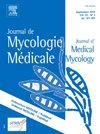Formulation and evaluation of herbal essential oil based nail lacquer for management of onychomycosis
IF 1.8
4区 医学
Q3 MYCOLOGY
引用次数: 0
Abstract
Introduction
Onychomycosis (Paronychia) is a common fungal nail infection, characterised by thickened, discoloured and brittle nails often accompanied by pain and discomfort. It is one of the most prevalent fungal nail infections with the global incidence of >20 % affected commonly by Candida albicans and Candida parapsilosis. The market today is flooded with various antifungal therapies (Azoles, Imidazoles, Allylamines, etc.) but their clinical applicability is limited due to associated side effects. The study is an attempt to formulate essential oil-based nail lacquer against Candidal Onychomycosis.
Material and Method
Selection of essential oils and preparation of their blends (EOB) was made on basis of their antifungal activity (minimum inhibitory concentration; MIC and zone of inhibition; ZOI) and physiological effect they exhibit on varied pathological parameters of onychomycosis. Simultaneously, varied batches of nail lacquer (N1-N5) were prepared by varying the concentrations of polymer and film forming agent and were evaluated for their formulatory characteristics (drying time, incidence of white patches, film texture, etc.). Optimal nail lacquer batch was loaded with screened EOB and was evaluated for various characteristics and antifungal activity.
Result
The formulation F4 was found to form a smooth, transparent film over the nail with absence of any tackiness or white patches. Moreover, F4 formulation exhibited minimum MIC among varied batches and higher ZOI (4.3 cm) as compared to marketed preparation (3.5 cm), indicating better antifungal activity.
Conclusion
Essential oils, as an active agent, could prove to be a natural, safer, and more effective alternative to the conventionally available topical preparations for the management of fungal infections. The development of this herbal mixture opens up new possibilities for treating onychomycosis, necessitating additional research and clinical studies to establish its clinical safety, efficacy, and viability.
用于治疗甲癣的草本精油指甲油的配制与评估
简介甲癣(甲旁癣)是一种常见的真菌性指甲感染,主要表现为指甲增厚、变色和变脆,通常伴有疼痛和不适。它是最常见的真菌性指甲感染之一,全球发病率超过 20%,主要由白色念珠菌和副丝状念珠菌引起。目前,市场上充斥着各种抗真菌疗法(偶氮类、咪唑类、烯丙基胺类等),但由于相关副作用,其临床适用性有限。本研究尝试配制以精油为基础的指甲油,以防治念珠菌性甲癣:材料和方法:根据精油的抗真菌活性(最低抑菌浓度和抑菌区)以及它们对不同真菌病病理参数的生理效应,选择精油并配制它们的混合物(EOB)。同时,通过改变聚合物和成膜剂的浓度制备了不同批次的指甲油(N1-N5),并对其配方特性(干燥时间、白斑发生率、膜质等)进行了评估。在最佳指甲油批次中加入筛选出的 EOB,并对其各种特性和抗真菌活性进行评估:结果:F4 配方在指甲上形成了一层光滑透明的薄膜,没有任何粘性或白斑。此外,与市场上销售的制剂(3.5 厘米)相比,F4 制剂在不同批次中的 MIC 最低,ZOI(4.3 厘米)较高,表明其具有更好的抗真菌活性:精油作为一种活性剂,可以证明是治疗真菌感染的一种天然、更安全、更有效的替代品,可以替代传统的外用制剂。这种草药混合物的开发为治疗甲癣提供了新的可能性,但还需要更多的研究和临床研究来确定其临床安全性、有效性和可行性。
本文章由计算机程序翻译,如有差异,请以英文原文为准。
求助全文
约1分钟内获得全文
求助全文
来源期刊
CiteScore
5.10
自引率
2.80%
发文量
68
审稿时长
6-12 weeks
期刊介绍:
The Journal de Mycologie Medicale / Journal of Medical Mycology (JMM) publishes in English works dealing with human and animal mycology. The subjects treated are focused in particular on clinical, diagnostic, epidemiological, immunological, medical, pathological, preventive or therapeutic aspects of mycoses. Also covered are basic aspects linked primarily with morphology (electronic and photonic microscopy), physiology, biochemistry, cellular and molecular biology, immunochemistry, genetics, taxonomy or phylogeny of pathogenic or opportunistic fungi and actinomycetes in humans or animals. Studies of natural products showing inhibitory activity against pathogenic fungi cannot be considered without chemical characterization and identification of the compounds responsible for the inhibitory activity.
JMM publishes (guest) editorials, original articles, reviews (and minireviews), case reports, technical notes, letters to the editor and information. Only clinical cases with real originality (new species, new clinical present action, new geographical localization, etc.), and fully documented (identification methods, results, etc.), will be considered.
Under no circumstances does the journal guarantee publication before the editorial board makes its final decision.
The journal is indexed in the main international databases and is accessible worldwide through the ScienceDirect and ClinicalKey platforms.

 求助内容:
求助内容: 应助结果提醒方式:
应助结果提醒方式:


